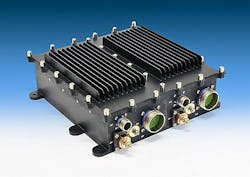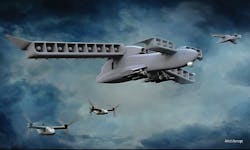Aurora Flight Sciences chooses AMETEK PDS power-distribution unit for XV-24A LightningStrike UAV
HARLEYSVILLE, Pa. – Unmanned aerial vehicle (UAV) designers at Aurora Flight Sciences in Manassas, Va., needed electric power distribution for the company's XV-24A LightningStrike unmanned vertical take-off and landing aircraft. They found their solution from the Power and Data Systems (PDS) business unit of AMETEK Aerospace & Defense in Harleysville, Pa.
Aurora Flight Sciences designers are choosing the Secondary Power Distribution Unit (SPDU) from the AMETEK PDS for the XV-24A LightningStrike aircraft, which is the basis of Aurora's entry in the Vertical Take-Off and Landing Experimental Plane (VTOL X-Plane) project of the U.S. Defense Advanced Research Projects Agency (DARPA) in Arlington, Va.
AMETEK PDS also is providing the company's SPDU power unit for the Aurora Flight Sciences Orion medium-altitude, long-endurance unmanned aircraft, which combines an efficient aerodynamic design with lightweight construction and efficient heavy fuel propulsion.
The compact lightweight AMETEK SPDU can distribute 288 amps of power at 28 volts DC to as many as 54 electrical loads. The unit saves weight, space, and cost by eliminating wires, circuit breakers, and utility boxes for a wide range of military and commercial aircraft and military vehicles, company officials say.
The SPDU provides circuit and wiring protection, as well as arc-fault detection, pulse width modulation, remote load power control, load power monitoring, automated load shedding, and prognostic and diagnostic maintenance capabilities.
The SPDU is look-up table configurable to enable its use on several different kinds of aircraft and other application without software or hardware changes, AMETEK PDS officials say.
Applications for the SPDU include distributing power to cabin and cockpit lighting; door, heater, potable water, and pump controls; fuel balancing and fire suppression systems; surface actuator controls; and ventilation fans.
Aurora Flight Sciences engineers are developing the DARPA VTOL X-Plane to have the hover capability of a helicopter, yet with the ability to fly nearly 50 percent faster than the Boeing V-22 Osprey tiltrotor aircraft.
Aurora is building the XV-24A LightningStrike UAV under terms of an $89.4 million contract awarded in March 2016. The unmanned aircraft will have a distributed hybrid-electric propulsion system with ducted fans; a synchronous electric-drive system; tilt-wing- and tilt-canard-based propulsion for vertical takeoff and landing; and high efficiency in hover and fast forward flight.
The aircraft design features a Rolls-Royce AE 1107C turboshaft engine that will power three Honeywell generators, and 24 ducted fans distributed on the wings and canards. Flight tests are scheduled for 2018.
The DARPA VTOL X-Plane project seeks to attain a top sustained flight speed of 300 to 400 knots; hover efficiency of at least 75 percent; cruise efficiency lift-to-drag ratio of at least 10; and useful load capacity of at least 40 percent of the vehicle’s projected gross weight of 10,000 to 12,000 pounds.
The Aurora Orion, meanwhile, holds the world record for flight duration of a remotely controlled UAV, based on the Orion’s 80-hour, 2-minute and 52-second flight in December 2014.
For more information contact AMETEK PDS online at www.ametekpds.com, Aurora Flight Sciences at www.aurora.aero, or DARPA at www.darpa.mil.
Learn more: search the Aerospace & Defense Buyer's Guide for companies, new products, press releases, and videos


